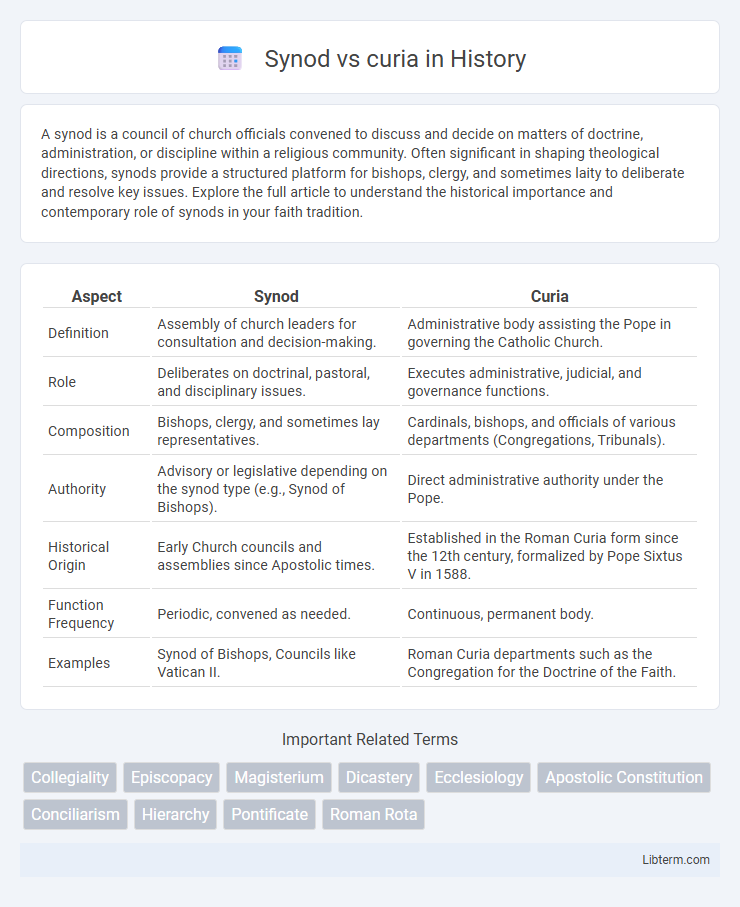A synod is a council of church officials convened to discuss and decide on matters of doctrine, administration, or discipline within a religious community. Often significant in shaping theological directions, synods provide a structured platform for bishops, clergy, and sometimes laity to deliberate and resolve key issues. Explore the full article to understand the historical importance and contemporary role of synods in your faith tradition.
Table of Comparison
| Aspect | Synod | Curia |
|---|---|---|
| Definition | Assembly of church leaders for consultation and decision-making. | Administrative body assisting the Pope in governing the Catholic Church. |
| Role | Deliberates on doctrinal, pastoral, and disciplinary issues. | Executes administrative, judicial, and governance functions. |
| Composition | Bishops, clergy, and sometimes lay representatives. | Cardinals, bishops, and officials of various departments (Congregations, Tribunals). |
| Authority | Advisory or legislative depending on the synod type (e.g., Synod of Bishops). | Direct administrative authority under the Pope. |
| Historical Origin | Early Church councils and assemblies since Apostolic times. | Established in the Roman Curia form since the 12th century, formalized by Pope Sixtus V in 1588. |
| Function Frequency | Periodic, convened as needed. | Continuous, permanent body. |
| Examples | Synod of Bishops, Councils like Vatican II. | Roman Curia departments such as the Congregation for the Doctrine of the Faith. |
Introduction: Defining Synod and Curia
A Synod is an assembly of church officials and representatives convened to discuss and make decisions on ecclesiastical matters, often focusing on doctrine, liturgy, or church governance. The Curia, specifically the Roman Curia, is the administrative apparatus of the Holy See, responsible for assisting the Pope in governing the Catholic Church through various offices and congregations. Understanding the distinct roles of the Synod as a deliberative body and the Curia as an executive administration highlights their complementary functions within the Church hierarchy.
Historical Origins of the Synod and Curia
The Synod originated in early Christian communities as local assemblies of clergy and laity to discuss church matters, tracing back to the Apostolic Age with councils like the Council of Jerusalem in Acts 15. The Roman Curia, by contrast, developed during the Middle Ages as the centralized administrative apparatus of the Holy See, evolving from papal chancery offices and college of cardinals established to support the Pope in governance and judicial functions. Historically, the Synod emphasizes collegial decision-making and pastoral consultation, while the Curia embodies hierarchical bureaucracy centralizing ecclesiastical authority within the Vatican.
Structural Differences Between Synod and Curia
The Synod functions as a representative assembly of bishops and other church members, focusing on collaborative decision-making and pastoral guidance. The Curia serves as the administrative apparatus of the Holy See, managing day-to-day governance, judicial matters, and implementation of papal policies. Structurally, the Synod emphasizes deliberative participation and consensus, whereas the Curia features a hierarchical organization with designated offices and dicasteries executing specific operational roles.
Roles and Functions of a Synod
A Synod serves as a consultative body within the Church, providing guidance on doctrinal, liturgical, and pastoral matters, often involving bishops, clergy, and sometimes laity. It functions to discern and address spiritual and administrative issues, shaping church policies and fostering unity among different dioceses. Unlike the Curia, which acts as the central administrative apparatus of the Vatican overseeing governance and day-to-day operations, the Synod emphasizes collaborative deliberation and pastoral consultation.
Roles and Functions of the Curia
The Curia serves as the central administrative body of the Roman Catholic Church, managing its day-to-day operations and implementation of papal directives. It oversees various departments, including the Congregations, Tribunals, and Pontifical Councils, facilitating governance, doctrinal enforcement, and judicial functions. Its primary role includes advising the Pope, coordinating diocesan activities worldwide, and ensuring the Church's canonical laws are uniformly applied.
Synod vs Curia: Authority and Decision Making
The Synod represents a collective assembly of bishops and church representatives exercising shared authority in doctrinal and pastoral decisions, fostering a more consultative and collaborative approach. The Curia, by contrast, functions as the central administrative body governed directly by the Pope, responsible for implementing decisions and managing the day-to-day operations of the Catholic Church. Synodal decisions emphasize wide episcopal input influencing church policy, whereas the Curia's authority lies in bureaucratic enforcement and centralized governance.
Interaction and Collaboration Between Synod and Curia
The interaction between the Synod of Bishops and the Roman Curia is essential for ensuring cohesive governance within the Catholic Church, facilitating dialogue on pastoral priorities and doctrinal matters. Collaborative efforts involve the Curia implementing synodal recommendations while providing canonical guidance and administrative support to synodal processes. This reciprocal relationship enhances ecclesial unity by aligning synodal insights with the structured execution of Church policies and initiatives.
Impact on Church Governance
The Synod represents a consultative assembly of bishops and other church members that facilitates broader participation and collaborative decision-making in Church governance. The Curia serves as the central administrative body, managing daily operations and ensuring the implementation of papal directives within the Catholic Church hierarchy. The dynamic interplay between the Synod and Curia significantly shapes policy development, doctrinal enforcement, and pastoral strategies, influencing the Church's responsiveness to contemporary challenges.
Contemporary Reforms of Synod and Curia
Contemporary reforms of the Synod emphasize enhancing collegiality among bishops and increasing lay participation to foster broader ecclesial discernment. Curial reforms focus on streamlining administrative structures, promoting transparency, and improving efficiency within the Roman Curia to better support the Pope's mission. Both reforms aim to modernize Church governance by balancing hierarchical authority with inclusive, consultative processes.
Synod or Curia: Future Challenges and Perspectives
The Roman Curia faces future challenges related to transparency, efficiency, and adapting to a globalized Church while maintaining doctrinal integrity. Synods offer a dynamic and consultative model, emphasizing synodality to enhance grassroots participation and responsiveness to contemporary issues. Balancing the authoritative role of the Curia with the synodal approach promotes a more inclusive governance structure that addresses the evolving needs of the Catholic Church.
Synod Infographic

 libterm.com
libterm.com